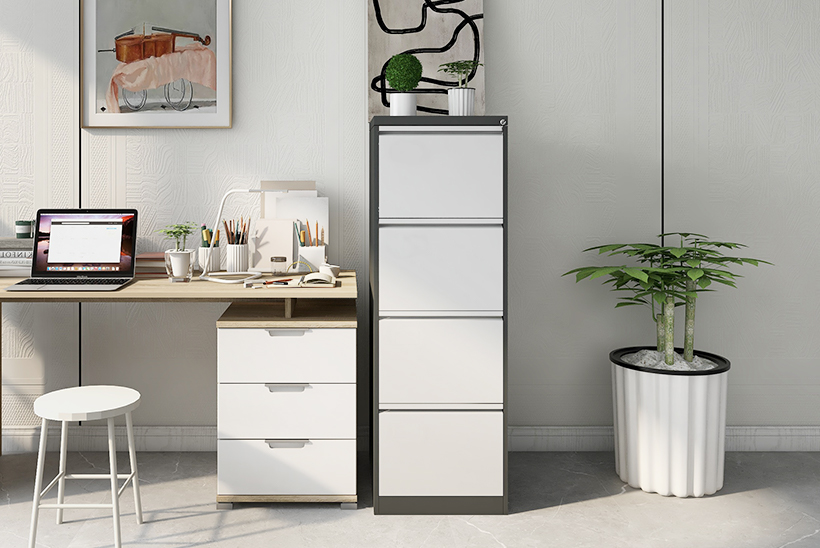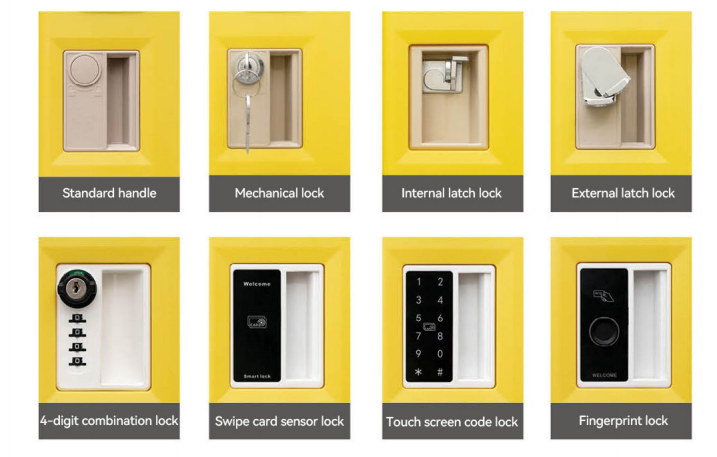
Losing your steel file cabinet key can be stressful, especially if you’re relying on a trusted file cabinet manufacturer for quality. Important papers might be stuck inside your home office file cabinet. But don’t worry! There are ways to open it without harm. First, look for a spare key. You can also contact the file cabinet manufacturer for help. If it’s in your home office, a simple solution may be close. No matter what, you have choices to fix this quickly.
Key Takeaways
- Look for extra keys first. Check places like drawers or ask trusted friends. A spare key can save time and worry.
- If the key is missing, find out the lock's brand and type. This helps you get a new key or contact the maker.
- Call a locksmith if nothing else works. They can open the cabinet without breaking it.
- Use a key tracker to avoid losing keys later. These gadgets help you find keys fast and skip searching.
- Make extra keys and keep them in safe spots. This way, you won’t get locked out again.
Immediate Steps to Take When You Lose a Key
Check for Spare Keys
Start by checking if you have a spare key. People often forget about duplicates they’ve made for file cabinets. Spare keys can save the day in moments like this. Think about where you might have kept it.
- Is it in a drawer or a safe?
- Could it be in a key holder or labeled box?
- Did you give a copy to someone you trust?
Having spare keys is not just helpful—it’s a smart idea. If you don’t have one, make a spare key after you get into your cabinet.
Search Common Places Where Keys Are Often Misplaced
Losing keys happens to everyone. Before worrying, check places where keys usually hide. Start with areas you use the most.
- Look in desk drawers, pockets, or bags.
- Check your car, like the glove box or cup holders.
- Search countertops, shelves, or spots you might have left them.
Keys sometimes end up in odd places. They could be under papers or in a jacket you haven’t worn in weeks. Take your time and think about where you’ve been. Lost keys often show up in obvious spots.
Identify the Lock Brand and Model for Replacement Options
If you still can’t find the key, focus on the lock. Knowing the brand and model of your file cabinet lock is important for getting a replacement.
Look closely at the lock for markings or numbers showing the manufacturer or model. Write these details down—they’ll help when contacting the maker or buying a new key.
Here’s a table of common lock models and their features:
| Lock Model | Type | Certification | Features |
|---|---|---|---|
| C8178 | Pin tumbler drawer lock | BHMA Certified Grade 2 | 7/8" cylinder length, key removable in both positions |
| C8173 | Pin tumbler door lock | BHMA Certified Grade 2 | 7/8" cylinder length, key removable in both positions |
| C9100 | Mailbox lock | USPS approved | 90 degree CW rotation |
| C8730 | Multi cam mailbox lock | USPS approved | Keyed different, 90 degree CCW rotation |
| C8747 | Disc tumbler locking handle | N/A | 1" spindle length, various keying options |
| C8703 | Deadbolt drawer lock | N/A | N/A |
Once you know the lock details, contact the manufacturer or search online for a replacement key. Don’t force the lock open—it could break the cabinet and cancel its warranty. If you’re unsure about the lock, a locksmith can help figure it out and suggest what to do next.
Note: Knowing your lock’s details helps you find the right replacement and keeps your cabinet secure.
Professional Help: Locksmith Services
Sometimes, calling a locksmith is the easiest way to open your steel file cabinet. Locksmiths are experts who fix lock problems fast and safely. Here’s when to call them, how to find a good one, and what it might cost.
When to Call a Locksmith
Call a locksmith if nothing else works. If you don’t have a spare key, can’t get a replacement, or feel unsure about DIY fixes, they can help. Locksmiths have the right tools to open your cabinet without breaking it.
If your lock is broken or old, locksmiths can repair or replace it. They can also install better locks for more security. Many locksmiths work 24/7, so you can get help anytime.
How to Find a Reliable Locksmith
Finding a good locksmith is simple if you follow these steps:
- Ask Around: Get advice from friends or check online reviews.
- Check Licenses: Make sure they have proper licenses and insurance.
- Experience Matters: Pick someone with lots of experience and skills.
- Service Options: Choose one who handles emergencies and other services.
- Quick Help: Look for locksmiths who respond fast, day or night.
- Clear Prices: Avoid locksmiths who don’t give clear price estimates.
- Real Location: Confirm they have a real office or store.
- Good Tools: Make sure they use modern, quality tools.
- ID Check: Ask for their ID to confirm they’re legit.
- Written Details: Get a written agreement about the work and cost.
- References: Ask for reviews from past customers.
- Trust Yourself: If something feels wrong, find someone else.
Costs and Timeframe for Locksmith Services
Locksmith prices depend on the job. Here’s a quick guide to common costs:
| Service Type | Estimated Cost |
|---|---|
| Emergency Lockout Services | $75 to $150 |
| Lock Installation | $100 to $200 per lock |
| Rekeying | $50 to $100 per lock |
| Key Duplication | $2 to $5 per key |
Most locksmiths can open a file cabinet in less than an hour. Bigger jobs, like installing a new lock, might take longer. Always ask how long it will take before they start.
Note: Locksmiths may seem expensive, but they’re worth it for safety and peace of mind.
DIY Methods to Replace or Bypass the Lock
Ordering a Replacement Key from the File Cabinet Manufacturer
If you lost your key, getting a new one from the file cabinet manufacturer is often the easiest solution. Many manufacturers use lock codes that are the same for their cabinets. To get a replacement key, find the code near the keyhole. You can then search online or contact the manufacturer to order a new key.
- Manufacturers often use similar codes, so finding the right one is fast.制造商经常使用类似的代码,因此找到合适的代码很容易。
- You can order keys without sharing personal details, but this might risk someone else accessing your files.
This method is simple but not perfect. If your cabinet holds important papers, think about whether this option is safe enough. Some people upgrade their locks after unlocking the cabinet for better security.
Tip: When buying replacement keys online, make sure the seller is trustworthy. It’s best to stick with the original manufacturer.
Using a Universal Key or Master Key
Universal keys or master keys can open many locks of the same type. If your cabinet has a common lock, you might find a universal key online or at a hardware store.
This works well for older cabinets or locks that aren’t complex. But check your local rules first. Some places don’t allow universal keys because of safety concerns.
Universal keys are helpful but not always dependable. Newer cabinets often have locks that don’t work with universal keys. If your cabinet has a modern or secure lock, this option may fail.
Note: Universal keys are only a short-term fix. For better safety, think about replacing the lock with a stronger one.
Picking the Lock (When Permissible)
Picking a lock might seem hard, but it can be useful in emergencies. If you need to open your cabinet quickly, you can try this—if it’s allowed where you live.
To pick a lock, you’ll need tools like a tension wrench and a lock pick. Put the wrench in the keyhole and press lightly. Then, use the pick to move the pins inside the lock. With practice, you can unlock the cabinet without breaking it.
Lock picking takes patience and careful movements. If you’re new, watch videos or practice on another lock first. Only pick locks on your own things or with permission.
Warning: Picking locks can break them or cancel warranties if done wrong. Be careful, and call a professional if you’re unsure.
Drilling the Lock as a Last Option
Drilling the lock might seem extreme, but it can help. If spare keys, locksmiths, or other methods fail, drilling may be your only choice. Here’s how to do it safely.
When to Drill the Lock
Drilling damages the lock, so only do it if necessary. Use this method if the lock is broken or you urgently need important papers. For example, if the cabinet holds work or legal files, drilling might be the fastest solution.
Important: Make sure you own the cabinet or have permission before drilling. Drilling without permission can cause legal trouble.重要提示 :在钻孔之前,请确保您拥有机柜或已获得许可。未经许可钻孔可能会引起法律麻烦。
Steps for Drilling
Drilling needs care and proper tools. Follow these steps to avoid mistakes:
- Get Tools Ready: You’ll need a drill, metal drill bits, goggles, and gloves.
- Find the Lock Center: Locate the middle of the lock where the pins are.
- Drill Slowly: Start with a small drill bit to make a guide hole. Use bigger bits to break the lock pins.
- Clean Up Debris: Remove any metal pieces left inside the lock.
- Open the Cabinet: Use a screwdriver to turn the lock after drilling.
If you’re not confident about drilling, don’t risk it. Mistakes can cost more than hiring a locksmith.
Tools and Materials Needed
Tools for DIY Lock Picking or Drilling
Planning to pick or drill a lock? The right tools matter. You don’t need to be a pro, but good tools help.
Here’s a list of what you’ll need:
- Beginners’ lock pick set: Includes 9 tools like a hook pick, diamond pick, and rake. These tools help you move the pins inside the lock.
- Tension tools: These hold the lock steady while you pick it. Without them, picking is much harder.
- Drill with metal bits: If drilling is your only option, use a strong drill with metal bits. This keeps the cabinet safe from extra damage.
- Safety gear: Wear goggles and gloves to stay safe from flying debris.
Tip: Practice picking on an old lock first. It helps you learn without damaging your cabinet.
Materials for Installing a New Lock
Replacing a lock? Use strong materials for better security. High-quality mortise locks or padlocks with changeable cores are great choices. Look for locks with rust-proof finishes like stainless steel or PVD coatings. These last longer and handle tough weather.
Note: Make sure the lock fits your cabinet before buying it.
Where to Purchase Tools and Materials
Finding tools and materials is simple if you know where to go. Hardware stores, locksmith shops, and online stores have many options.
- Local hardware stores: You can see the tools and ask for advice.
- Locksmith shops: They sell special tools and high-quality locks.
- Online retailers: Websites like Amazon let you compare prices and reviews.
Tip: Buy from trusted sellers online. Check reviews to avoid fake products.
How to Install a New File Cabinet Lock

Removing the Old Lock
Replacing your steel file cabinet lock starts with removing the old one. Follow these steps to make the process smooth:
- Empty the Cabinet: Take out all files and items. This prevents damage and gives you clear access to the lock.
- Locate the Locking Mechanism: Find the lock at the top or side of the drawer. Look for screws or clips holding it in place.
- Remove the Lock: Use a flathead screwdriver or pliers to loosen the lock. If it’s stuck, a drill might be necessary. Work carefully to avoid scratching the cabinet.
Tip: Keep the old lock and its parts in case you need them for reference or disposal.
Removing the lock doesn’t take long, but patience is key. Once the lock is out, you’re ready to install the replacement.
Installing the File Cabinet Lock
Installing a new lock is easier than you might think. Manufacturers often include instructions, but here’s a general guide:
- Check the Components: Make sure the new lock comes with all necessary parts, like screws, clips, or nuts.检查组件 :确保新锁随附所有必要的部件,例如螺钉、夹子或螺母。
- Measure for Compatibility: Confirm the lock fits the hole left by the old one. If it doesn’t, you may need to adjust the opening.
- Insert the Lock: Slide the lock into the hole. Secure it with the provided clip or nut. Tighten everything to keep the lock stable.
- Align the Mechanism: Ensure the latch aligns properly with the cabinet’s locking system.对齐机构 :确保闩锁与机柜的锁定系统正确对齐。
Installing the lock takes precision, but it’s worth the effort. A well-installed lock keeps your cabinet secure and functional.
Testing the New Lock for Proper Functionality
Testing ensures your new lock works as expected. Here’s how to check its performance:
- Lock and Unlock: Use the key to lock and unlock the cabinet several times. Make sure it operates smoothly without sticking.
- Check Alignment: Confirm the latch aligns perfectly with the locking mechanism. Misalignment can cause issues later.
- Simulate Repeated Use: Open and close the cabinet multiple times to test durability.
Testing isn’t just about functionality—it’s about peace of mind. A reliable lock protects your files and keeps your cabinet secure.
Ensuring Compatibility with Your Cabinet
Before buying, make sure the lock fits your cabinet. A proper fit avoids problems during setup.
- Measure the Lock Opening: Use a ruler to check the size of the lock hole. Compare it with the new lock’s size.
- Match the Lock Type: Cabinets often use cam locks, deadbolts, or disc tumbler locks. Pick the same type as your old lock.
- Check the Locking Mechanism: Make sure the new lock works with your cabinet’s latch. Misaligned locks won’t work properly.
Choosing the right lock is simple. Focus on quality, trusted brands, and a good fit to keep your cabinet safe.
Preventive Measures to Avoid Losing Keys in the Future
Using a Key Tracker or Key Finder Device
Ever misplaced your keys and spent hours searching? A key tracker or key finder device can save you from that hassle. These gadgets use Bluetooth or GPS to help you locate your keys in seconds. You can attach them to your keyring, and with a simple tap on your phone, you’ll know exactly where they are.
These trackers are easy to use and affordable. They’re perfect for busy people who often misplace things.
Creating and Storing Spare Keys
Making spare keys is one of the smartest ways to avoid future headaches. You never know when you might lose your main key, so having a backup is essential.
Start by creating duplicates of your steel file cabinet key. You can get this done at a hardware store or locksmith shop. Once you have spares, store them in safe but accessible places.
Having spares gives you peace of mind. You won’t have to worry about being locked out of your cabinet again.
Note: Avoid hiding spare keys in obvious spots like under a mat or inside a flowerpot. Thieves know these tricks!
Labeling and Organizing Keys for Easy Access
Ever struggled to figure out which key opens what? Labeling and organizing your keys can make life so much easier.
Use key tags or stickers to label each key. Write down what it’s for—like “File Cabinet” or “Garage”—so you don’t have to guess. You can also use color-coded tags to group keys by purpose.
Organize your keys in a holder or a small box. Choose one with compartments to keep everything neat. If you have a lot of keys, consider a wall-mounted key rack for quick access.
Losing your steel file cabinet key isn’t the end of the world. There are many ways to open it again. Being ready and picking the best solution will protect your cabinet and files. Act now to stay worry-free later!





